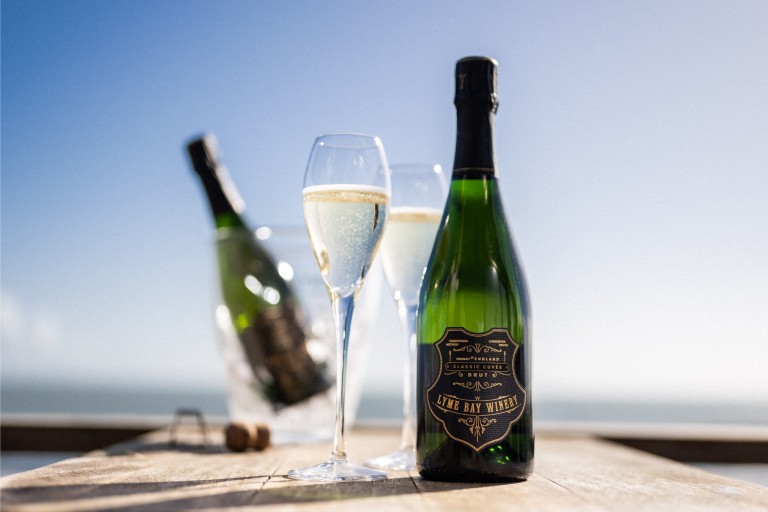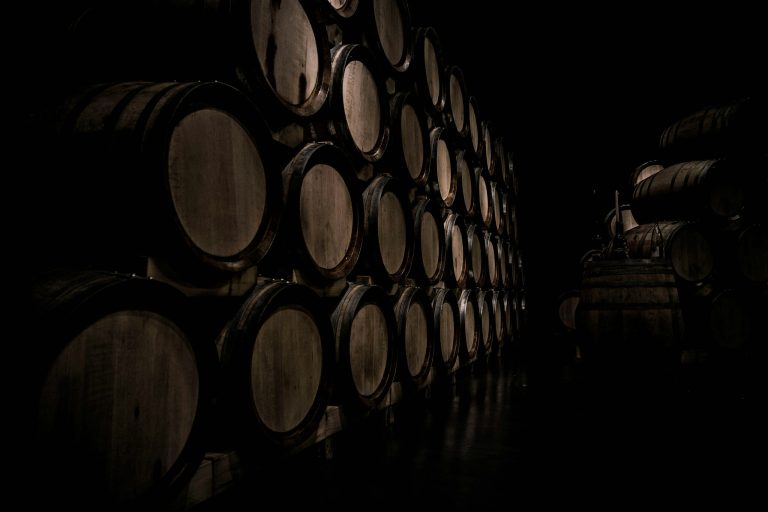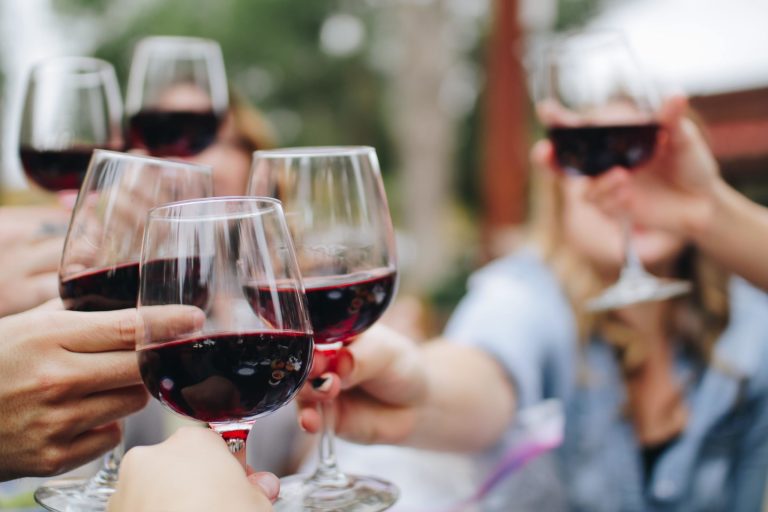“2021 was extremely challenging, but ultimately an absolute triumph”, says Duncan McNeill – site manager for all the premium vineyards Lyme Bay works with across the Crouch Valley in Essex – summing up the highs and lows of the year’s growing season.
Bud burst delay
The year began with a wet winter ushering in the second driest February, March and April of the last 16 years, dominated by high pressure and cold northerly and easterly winds. In fact, April 2021 was the coldest recorded in over 100 years, with more nights of frosts than in recent history.
“Mild frost damage did occur in small pockets, with Chardonnay being most affected, but thankfully the losses were not significant”, says Duncan, “although this delayed bud burst until the third week of April across all our vineyard sites in the South East region.”
May saw a dramatic change in rainfall, with 76mm that month alone – compared with 55mm throughout the whole of February, March, and April – and temperatures remaining stubbornly low due to the ongoing north-easterly wind directions. “With daytime temperatures failing to break 20 degrees Celsius, the threat of further night-time frosts remained ever-present”, says Duncan, “and we saw a frustratingly slow emergence of shoots, leaves and inflorescences around the region.”
Late flowering
Flowering was consequently very late – around 25th June, compared with the 4th of June in 2017, 9th June in 2018 and 12th June in 2020 – but there were other hurdles to tackle.
“Forty millimetres of rain placed incredible pressure on the developing inflorescences, which are very susceptible to downy mildew infection during the pre-flowering period”, says Duncan, “and heavy rainfall between 16th-18th June caused the first primary infection prior that season.”
Once flowering began, frequent rain showers placed the pollination of the crop in jeopardy (a further 46mm of rain fell between 25th June and 12th July) and cold temperatures sticking steadfastly at less than 20 degrees C meant flowering was not fully completed until around the 15th of July.
“Thankfully, fruit set was generally very good”, says Duncan, “although numerous downy mildew infection events during this period, unfortunately, meant that the appearance of downy mildew oil spots on the leaves in all vineyards was inevitable.”
Ripe and ready
The north-easterly wind continued to sweep in cold air well into July for the first time since vineyard observations began in 2006, and temperatures throughout July and August remained in the low 20s, with a higher-than-average level of cloud cover.
“A more challenging growing season up to this stage was hard to imagine”, says Duncan. “The first evidence of veraison – the onset of the ripening of the grapes – was seen at Martin’s Lane Vineyard in Stow Maries on 25th August in Pinot Noir, but even this was nine days later than the ‘benchmark’ date of 16th August for our region in previous years.”
September finally saw the arrival of hot and dry weather. Rainfall this month was only 37mm and temperatures broke 30 degrees C, with 2021 only the sixth time in 60 years that September has been warmer than August.
However, despite the warm weather, it became clear that to achieve the physiological and sugar ripeness we need in order to make our still English wines, the grapes would have to hang on until November. “A dry autumn was required, and thankfully this is by and large what occurred”, says Duncan. “Despite 52mm of rain in the first three days of October, a dry spell of two weeks followed, chased by a further 28mm of rain around the 19/20th October, but we weren’t too worried as previous experience told us that sugars would recover given time.”
Harvest high
We harvested all premium Pinot Noir and Chardonnay grapes for Lyme Bay Wines Tier 1 still wines in November, which was necessary to ensure that target sugar levels were achieved, and that the grapes reached full physiological ripeness.
“We watched carefully to the point at which full fruit maturity was reached, the seeds turned brown and tannins in the skins softened”, says Duncan, “as the longer the time given for this process to take place, the more complex the rounded the flavours and mouthfeel of the wines will be.”
Grapes with potential alcohol levels of >13% were harvested from numerous vineyards in the region, something which back in August had seemed inconceivable but, adds Duncan: “It is worth noting that the strong correlation between date of bud burst and date of harvest was borne out yet again: late bud burst follows with a late harvest.
“We also made the decision to reduce our Pinot Noir yields to 2 tonnes per acre as a maximum, though our actual yields were closer to 1.5 tonnes per acre. To put this into context, this equates to around 24 Hl/ Ha, which is comparable with Burgundy grand crus. This, coupled with the natural terroir of the sites, is what enabled us to match and arguably exceed the terrific ripeness of 2020.”
Flavour results
So far, grapes of the right clones from the right sites are showing exceptionally exciting physiological ripeness and depth of flavour because of the extremely long extended ‘hang time’ (particularly for Pinot Noir), which Duncan says, happily, “were beyond our expectations for the year, and is why the challenging 2021 growing season turned out to be a triumph. In one of the most difficult growing seasons ever, we were able to demonstrate that with a focus on quality and careful vineyard management, it is indeed possible to grow world-class still wines in the best vineyards of England.”
Winter work
Lyme Bay Winery works with some of the most dedicated vineyard owners across the country – including in Essex, Dorset, Devon, Hampshire and Oxfordshire – to source the best English grapes to make the best possible English wines, and like any process dependent on the bounty of the land, the work of our viticulturists never stops.
At another Essex site from where we source some of our Pinot Noir, Chardonnay and Bacchus grapes, Martin’s Lane Vineyard partner Roy Martin is getting ready for the next stage in the cycle, with the crucial task of pruning the vines about to begin.
“Pruning is better understood nowadays as vitally important for the prospects of fruiting performance in the following season as well as ensuring the continued wellbeing and longevity of the vines”, explains Roy.
Timing is key when it comes to pruning different varieties, as pruning can often hasten early growth, and delaying it can sometimes succeed in holding back budburst in areas where late frosts can pose a danger. This means those varieties known to develop early may be last in the pruning sequence.
“The practice of using ‘gentle pruning’ techniques by respecting the future growth and development of the vine to avoid concentration of tissue-scarring is now also widely adopted”, says Roy, “and this has contributed greatly towards more consistent fruiting results whilst ensuring the long-term health of the vine.
“Pruning methods are equally important as we move towards more controlled and managed yields to attain the optimum ripeness in our fruit where an approach of ‘less is more’ is being widely adopted, particularly among the ‘classic’ grape varieties, which at Martin’s Lane are directed almost exclusively towards premium quality still wines.”
Nonetheless, this can still pose questions whether for some varieties it is better to remain with the more widely adopted ‘cane pruning’ using the previous year’s growth for fruiting, or to consider ‘spur pruning’ to create a ‘cordon’ – a permanent horizontal extension of the trunk that remains in place year after year. Spur pruning is known to produce marginally less fruit so this can make sense in some varieties where a reduced yield and higher ripeness in the fruit is the objective.
“So while it might not look as if there’s much happening in the vineyard at the moment there are lots of decisions to be made in this winter period”, says Roy, “with all focus again on producing the very best fruit we can in the year ahead.”
If careful planning is any measure of future success, we are certainly doing our best to stay on the right track.


